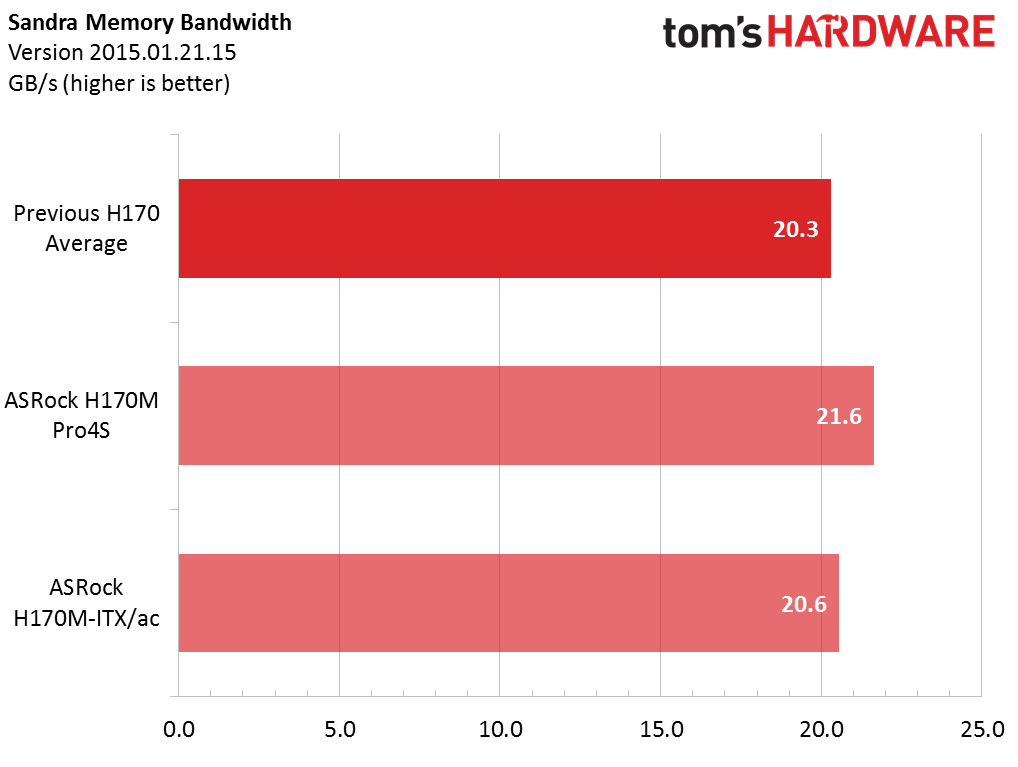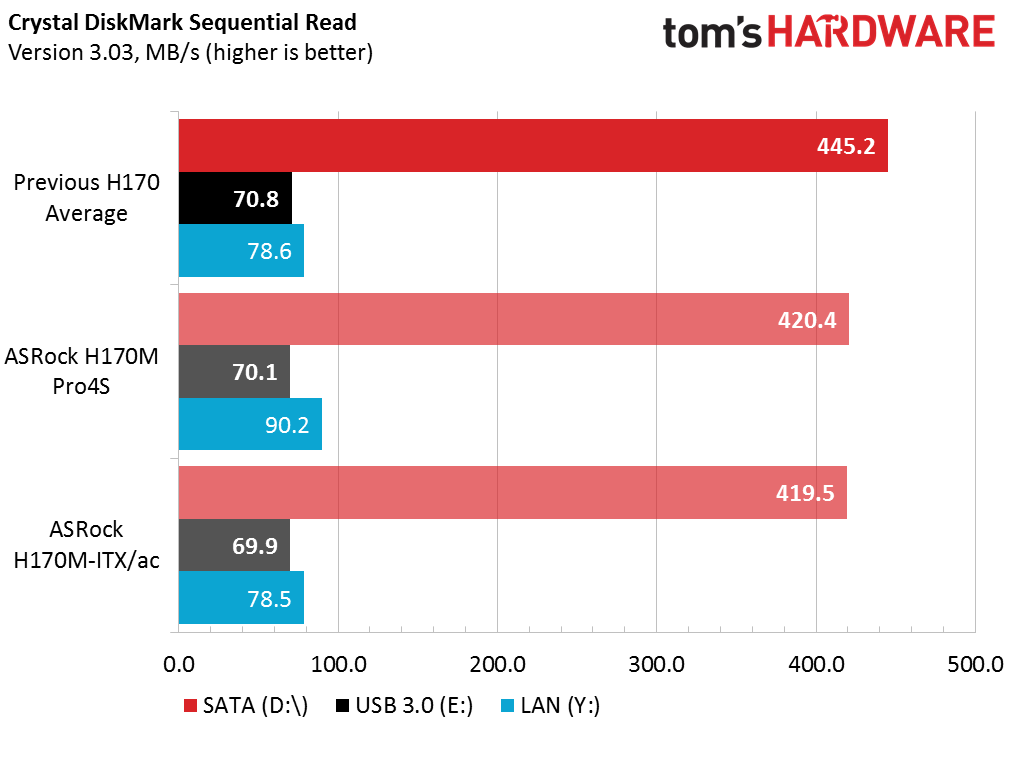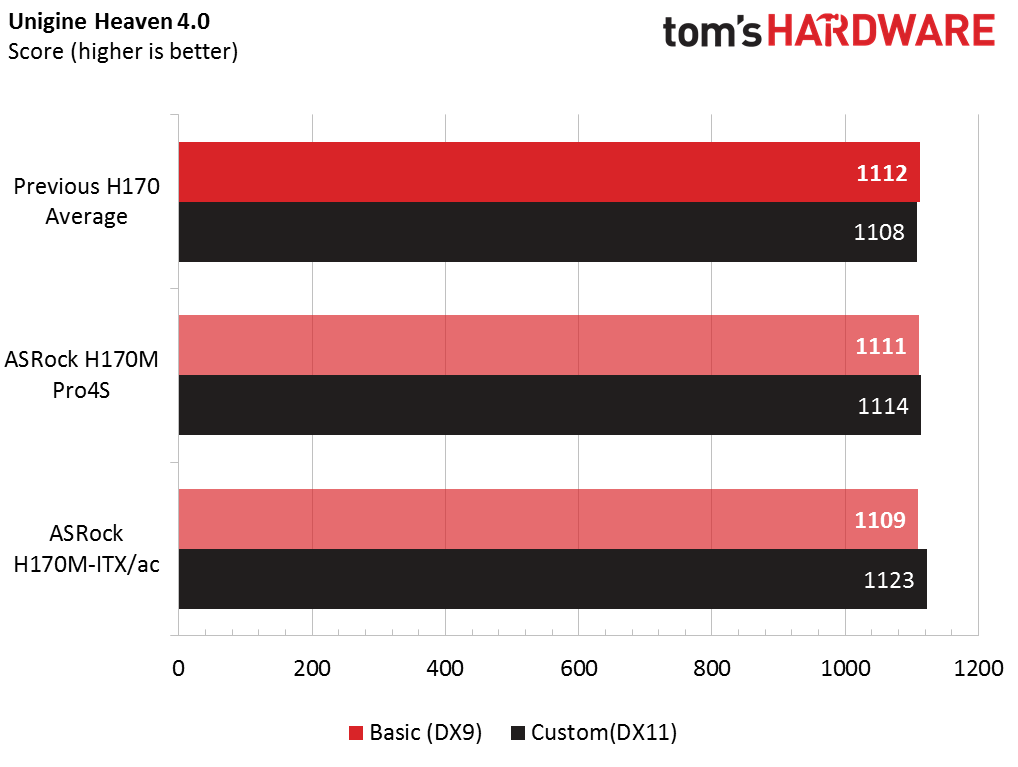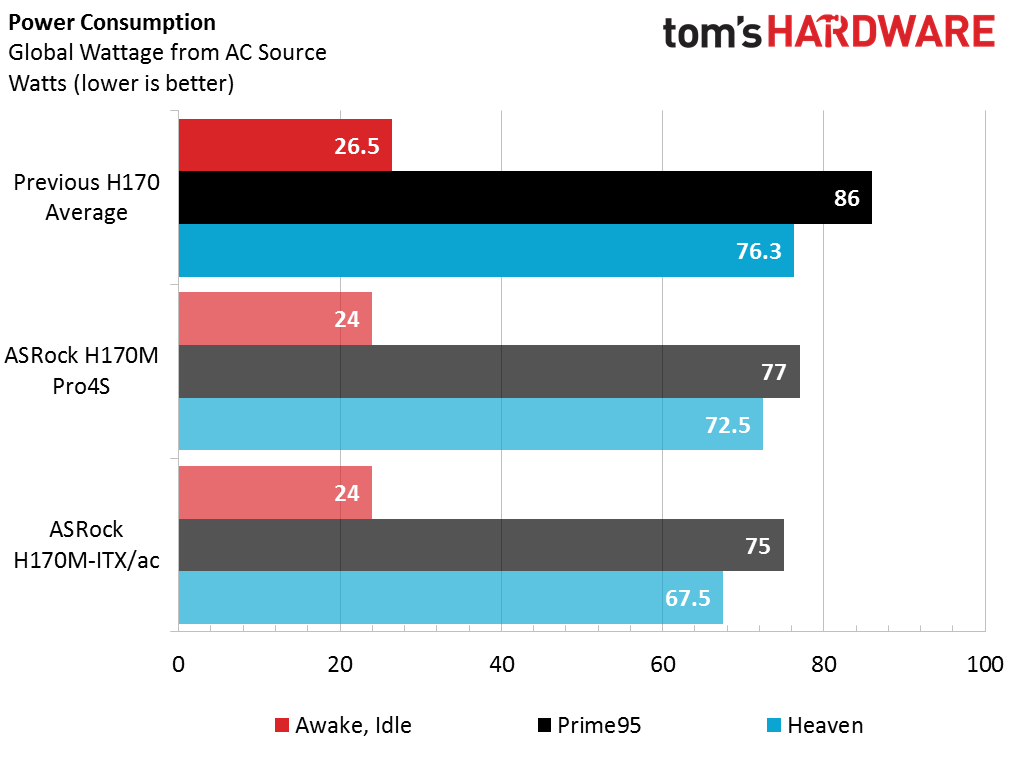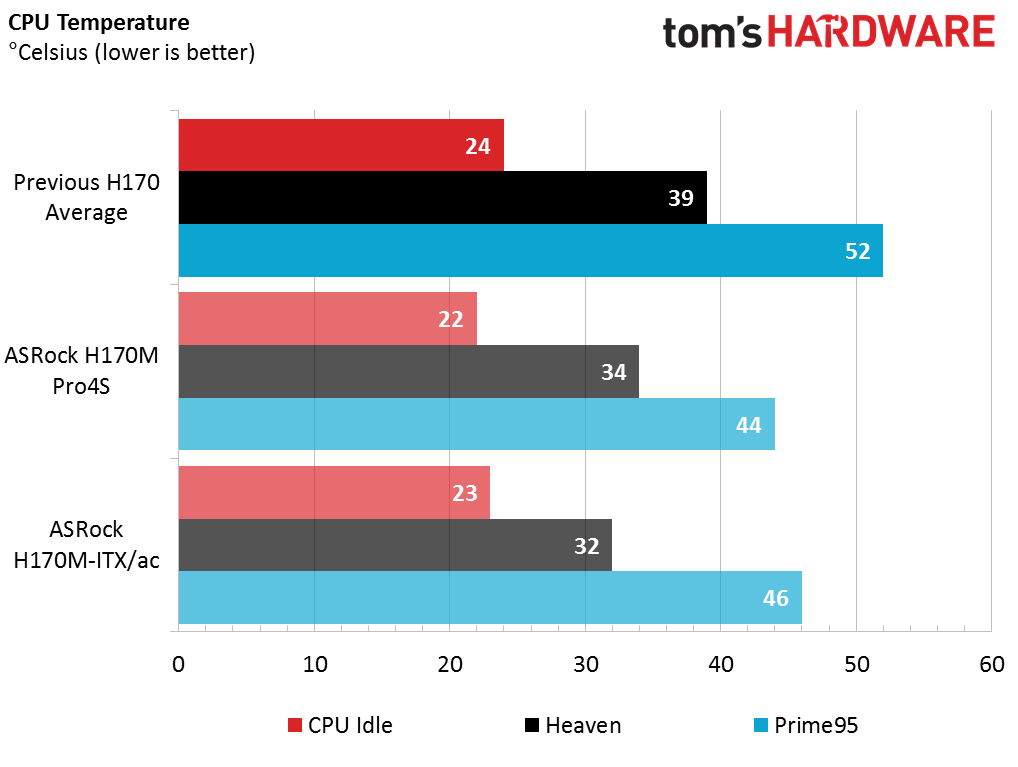ASRock H170M Pro4S And H170M-ITX/ac Motherboard Reviews
Why you can trust Tom's Hardware
Test Settings, Results And Final Analysis
As in previous tests, all motherboards were set up on an open-bed test case. All components, other than the motherboard, were the same in all of the tests.
Test System Configuration
| Sound | Integrated HD Audio |
|---|---|
| Network | Integrated Gigabit Networking |
| Graphics | Nvidia 347.25 |
| Synthetic Benchmarks And Settings | |
| PCMark 8 | Version: 2.5.419Work, Home, and Creative Benchmarks |
| SiSoftware Sandra | Version: 2015.01.21.15Memory Bandwidth |
| Crystal DiskMark 3.03 | 3.0.3 x64 Sequential Read |
| Unigine Heaven 4.0 | Version 4.0, Built-in BenchmarkBasic: DirectX 9, Low Detail, 1280x720, 2xAA, No Tessellation |
Test Results
Here are the test results, starting with PCMark8.
As we've seen before, the differences are small, although both of these ASRock boards are a little above average in all categories.
Once again, the ASRock boards both beat the average, but the differences are small.
Now, we see some different results. The ASRock tag team loses five out of the six tests. There's no obvious explanation for why the Pro4S wins one test by an almost 15-percent margin. I used the Intel NIC on both boards, and as the five-board roundup explained, I have modified the test environment. I have removed the factors beyond my control that are inherent to the speedtest.net LAN throughput test I was using last year. All of the boards, except for the MSI from the previous roundup, also use an Intel NIC. I did not load CFOSPEED or any other LAN utility on any board. I duplicate my test runs, so I'm inclined to simply crown a winner and move on.
Nothing to see here folks; move along—both of today's boards are slightly below the average on the DX9, and slightly above average in the DX11. You couldn't fit a cat's whisker between the scores, though (I have cats; I tried).
Now here's a pretty solid victory for ASRock. When we look at the previous roundup, we see that ASRock's power numbers were good there, too.
Get Tom's Hardware's best news and in-depth reviews, straight to your inbox.
That Noctua cooler doesn't let any of these CPUs heat up. But here again, correlated with the lower power numbers, ASRock sweeps these tests with victories across the board, winning most by over 10 percent.
Final Analysis
I could not justifiably criticize a builder for choosing either of these boards, although I might ask a cautionary question or two about something specific.
ASRock H170M Pro4S
This board costs $10 less than the H170M Pro4. Are the sacrifices worth the $10? That's a tough call, and it's really a matter of opinion. Fewer video-output options may be a big deal if you aren't planning to use a discrete graphics card, but if you install a graphics card, then another $10 may not strain your budget. I prefer the way the orange on the Pro4 pops, but that's also a matter of opinion. This is not a bad board, so I'd rather be criticized for praising it rather than have someone overlook it.
ASRock H170M-ITX/ac
I prefer smaller systems, but when I decided that Scrooge (my previous "lab assistant") was not fast enough, this board was not my choice. Instead, I selected the MSI H170I Pro AC I has reviewed previously. The H170M-ITX/ac layout was uncomfortable, and I decided I may someday want to add an M.2 drive, which would not be possible on the H170M-ITX/ac if I wanted to keep the wireless network controller. Furthermore, I'd be limited to physically (and likely logically) smaller drives that are mSATA-only. The H170M-ITX/ac does not offer diagnostic LEDs of any kind, unlike the MSI offering. Although it's $20 cheaper, it wasn't worth it to give up features that I could see myself wanting later on. On the other hand, the H170M-ITX/ac saves you $20 and gives you another LAN port. If you need another LAN port, then that might be a great deal. If you want low power consumption and lower heat production, this may be the board for you—just be sure you don't also need a PCIe M.2 slot.
Conclusion
Once again, I think the H170 chipset should appeal to a great many builders. Although budget builders might feel limited to H110 or B150, the $30 to $50 difference to jump up to H170 buys a lot of future resistance in terms of the number and types of ports, and possibly another pair of RAM slots. Only users who need more robust support for multiple graphics cards, or for whom overclocking and tweaking are particularly important, will need to move all the way up to Z170. I've had the opportunity to present seven H170 boards now, and none of them has left me thinking, "Now why would anyone choose that?"
MORE: Best MotherboardsMORE:
How To Choose A Motherboard
MORE: All Motherboard Content
MORE: Motherboards in the Forums
Joe Trott is an Associate Contributing Writer for Tom's Hardware, covering Motherboards.
Follow us on Twitter @tomshardware, on Facebook and on Google+.
-
joz Nice to see Mushkin getting some action - even if it is just as components for testing other components.Reply
-
Onus I've used a fair number of Mushkin parts over the years, and I only recall a single RMA on some DDR2 years ago. One of my oldest SSDs is the one in my wife's PC, and you can be sure I'd be hearing about it if it were not reliable. I'm generally confident in the brand.Reply -
logainofhades Seems like, for most people, H170 boards are a great choice. I have been pretty happy with mine, that was in the last H170 review. Eventually I will swap for a Z170, and reuse it somewhere else. The lack of PCI-E M.2, on the ITX board, is a bit of a letdown. If I were to build an ITX rig, I would probably consider that feature a must have.Reply -
Onus That is why I chose the MSI board to keep for Igor, in case I wanted to add a PCIe M.2 drive later.Reply
It's a low priority, because interest in nearly identical products isn't going to be high, but I've got two more H170 boards left, the H170 Pro4 and the H170 Pro4S, also both ASRock. I want to get one of them on the bench tonight. In order to maintain interest, I may use it to generate a couple more data points, like comparing Windows 8 and Windows 10 through the same tests. -
pjc6281 no USB 3.1 is the downside for me on both of these. Trying to plan for a nice mini system with a H170 MB and 3.1 is hard to come by.Reply -
rwinches Both boards appear to have the same DVI-I ports in the images.Reply
The Pro4s description of the DVI-I port limitation is missing the words 'do not'
'VGA adapters (do not) work on DVI-I ports, so an adapter won't be an option here.' -
Lutfij Agreed, when going to the smallest form factor possible the benefit of having slim/stealthy or equally smaller components aids in bringing about a small, functional and compact system.Reply
The only thing is I know most people would opt for audio pass through via the HDMI port but I equally know folks who yet have an audio/video receiver that handles discrete multi channel surround sound so a higher quality audio chip would be something in my books though it would only jack up the prices up and float this board closer to enthusiast grade boards. -
Onus The DVI ports do indeed look like DVI-I, but the manual describes them as DVI-D. I will look out for this in the future and actually test them with an adapter I have.Reply

